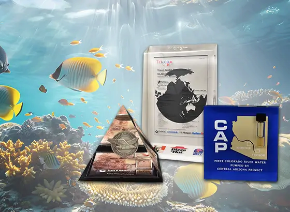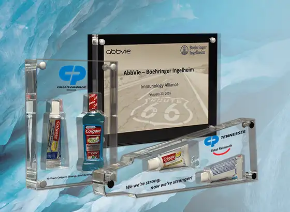
Since their introduction, acrylic trophies have undergone a fascinating evolution, reflecting broader trends in design, technology, and cultural values. From their humble beginnings as simple, functional awards to their current status as versatile and sophisticated symbols of achievement – acrylic trophies have mirrored changes in materials and aesthetics. Here's a closer look at how these trophy designs have shifted over the years and what that signifies about broader award presentations and design trends.
 Simplicity and Function Were Trademarks of Early Acrylic Awards
Simplicity and Function Were Trademarks of Early Acrylic Awards
The earliest acrylic trophies were primarily valued for their beauty and practicality. In the mid-20th century, Acrylic, or polymethyl methacrylate (PMMA), emerged as a popular alternative to glass. It was cheaper, lighter, and more durable, making it an appealing choice for awards. The early designs were straightforward and utilitarian. Award manufacturers used acrylic primarily for its functionality—its ability to be easily molded and its clarity made it a low-cost replacement for glass without the risk of breakage.
These initial acrylic trophies were often basic blocks or simple geometric shapes laser engraved with text or logos. The focus was on providing a durable and cost-effective solution for recognizing achievement rather than on creating a piece of art. The emphasis was on practicality rather than aesthetics, and the designs were typically minimalist.
 Customization and Creativity Led to Unique Design Innovations
Customization and Creativity Led to Unique Design Innovations
As technology advanced and acrylic processing capabilities improved, trophies' designs began to shift. The 1980s and 1990s saw a surge in creativity and customization. Advances in laser engraving and Lucite® molding allowed for more intricate designs, enabling trophy manufacturers to offer customized options for different events and achievements.
During this period, acrylic trophies featured more elaborate shapes and textures. Manufacturers experimented with colored acrylics and layered designs, which added depth and visual interest. This era marked the beginning of the acknowledgment of acrylic trophies for their function and aesthetic appeal. Customization became a key feature, with acrylic trophy designs reflecting the specific nature of the award and the purpose for presenting it.
 Integration with Modern Design Trends
Integration with Modern Design Trends
Acrylic trophies evolved further in the 2000s and 2010s in response to broader design trends. The use of multi-layered and multi-colored acrylics became more prevalent, with designers incorporating LED lighting and other modern elements to enhance the visual impact of the trophies. Combining acrylic with different materials, such as metal or wood, became popular, adding a touch of sophistication and elegance to the trophies.
In this period, the influence of modernist and contemporary design principles became evident. Acrylic trophies started adopting sleek, clean lines and geometric forms aligned with minimalist and futuristic aesthetics. The material's versatility allowed designers to push boundaries, creating trophies that were not only awards but also artistic pieces.
 Technological Advancements
Technological Advancements
Technological advancements have also continued to shape the evolution of acrylic trophies. Innovations in full-color digital printing and laser technology have made it easier to produce high-quality, detailed designs with greater precision. Integrating innovative technology, such as embedded QR codes and customer-supplied objects displaying personalized messages, is an emerging trend that adds a new dimension to award presentations.
 Cultural Shifts and Personalized Recognition
Cultural Shifts and Personalized Recognition
Cultural shifts have also influenced acrylic trophies toward more personalized and meaningful recognition. The growing emphasis on individual achievement and the desire for unique, tailored awards have led to an increase in custom-designed trophies that reflect the personal milestones and preferences of the recipients. This trend is evident in the rise of trophies that incorporate personal stories, achievements, or even photographs, creating a more intimate and memorable award experience.
In today's market, there is a greater appreciation for the stories behind the awards. Acrylic trophy designers like US Acrylic Awards create shapes to symbolize the achievement, the journey, and the effort behind the achievement. This shift aligns with broader cultural trends that value personal narratives and authentic recognition.
 The Future of Acrylic Trophies
The Future of Acrylic Trophies
The future of acrylic trophies will likely be shaped (no pun intended) by ongoing advancements in materials, technology, and evolving design preferences. As sustainable practices become increasingly important, we can expect further innovations in eco-friendly materials and production methods. Additionally, integrating interactive elements and digital features may become more common as technology advances, offering new ways to celebrate and recognize the achievements of hard-working individuals.
In conclusion, acrylic trophies have come far from their early utilitarian forms
Their evolution reflects broader changes in design, technology, and cultural values. From simple, functional awards to sophisticated, personalized symbols of achievement, acrylic trophies have adapted to meet the needs and preferences of their recipients, continuing to offer a meaningful way to recognize success in various fields. As we look to the future, it's clear that acrylic trophies will continue to evolve, embracing new technologies and design philosophies while remaining a beloved choice for celebrating excellence.
US Acrylic Awards is an American manufacturing company selling products made in the USA by skilled craftsmen and women. We look forward to challenging design concepts and consider it an honor to create many of the finest acrylic trophies and awards available today







